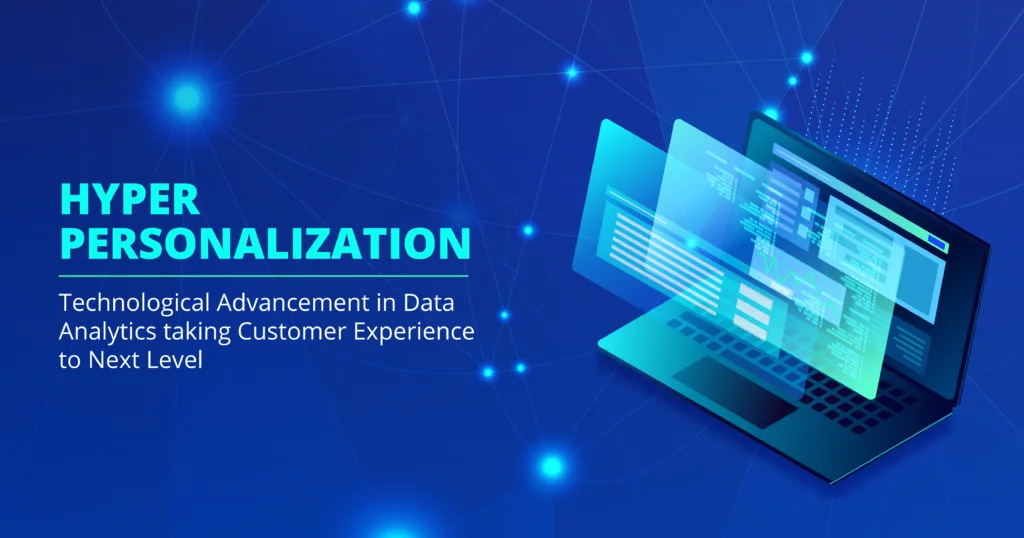Today, consumers are more demanding than ever. They want more personalized experiences from the brand. Customers are willing to be recognized as individuals rather than being known as whole numbers. Customers are an asset to every business organization and the purpose of every enterprise is to make their customers happy.
Tailoring customer needs and wants on an individual basis is what enhances the customer experience. It is about what they want to watch, hear, or buy. Personalizing messages with a name is not enough, but a clear insight into the customer is important. This all is possible with Hyper Personalization. But, what is hyper Personalization?
This article is all about what hyper-personalization is and how to deliver customized experiences with AI.

What is Hyper Personalization?
The hyper-personalization is a process that is a one-to-one marketing strategy that is established to enhance the customer experience and get them attached to the brand emotionally. It is a procedure where the needs and wants of an individual are curated by using real-time data, Artificial Intelligence, automation, and predictive analytics to analyze what each customer wants.
It is a unique strategy for customers to have an exceptional experience, rather than a market strategy that fits all. It is not about segmenting the market into groups but referring to each customer with their preferences.
The question lies, what is the actual difference between personalization and hyper-personalization?
Difference between Personalization and Hyper Personalization?
Talking about Personalization is similar to what hyper-personalization is. Personalization aims to provide personal services to every individual. What differentiates them from each other is the technology, the kind of data, and the level of personalization.
Let’s have a deep look into the characteristics that help discriminate each of them from one another.
1. Data
Standard personalization is what uses basic data like name, sex, demographics, or purchase history. However, hyper-personalization takes a deep dive into the data. It uses machines and technology to collect more real-time complex data. The data-driven is about interests, browsing history, or customer behavior.
2. Technology
While standard personalization utilizes techniques like analytics, automation, and rules-based targeting to gather customer information, hyper-personalization elevates the process by employing advanced AI capabilities. In contrast to standard personalization’s reliance on these traditional methods, hyper-personalization harnesses the power of AI, predictive analytics, sentiment analysis, and machine learning to gain a deeper understanding of customer behavior. Moreover, technology has revolutionized how businesses approach marketing, enabling them to leverage data-driven strategies powered by AI to achieve a comprehensive 360-degree view of their customers. Furthermore, this holistic understanding empowers businesses to craft personalized marketing campaigns that resonate with each individual customer, fostering stronger relationships and driving enhanced results.
3. Level of Personalization
While standard personalization leverages online data to deliver customer experiences, hyper-personalization takes a quantum leap forward. In contrast to standard personalization’s reliance on online data, hyper-personalization employs a sophisticated arsenal of data collection tools, extending its reach beyond the digital realm. Moreover, hyper-personalization harnesses cutting-edge AI tools, including chatbots, voice search optimization, websites, and mobile applications, to gather a comprehensive understanding of customer preferences and predict their future actions. Furthermore, these high-tech algorithms provide businesses with an unprecedented level of granularity into customer behavior, enabling them to tailor experiences with remarkable precision.
How does hyper-personalization improve customer experience?
Customers love attention and personalized services. Hyper-personalization can help improve customer experience and benefit the business itself in many ways. Some of them are:
1. Delivers individual experience
People are always looking for a great customer experience when they interact with brands. They want to have food service, promotional offers, site visibility, speed, and data protection. These are a few elements every customer looks into a brand. However, today customers want more of a personalized service even in exchange for data.
All this is possible with hyper-personalization where brands deliver individual experiences for the people which persuades them to buy from the brand. Talk about prices, products, or offers; all are tailored to individual needs and wants.
2. Boosts brand loyalty
Consumers can easily shift their choices and brands if they are not satisfied with the services. The competition is too high and brands have to maintain their standards to retain brand loyalty. Hyper-personalization can keep customer loyalties intact by providing customers with tailored services that would enhance the customer experience.
A consumer is likely to stay with a brand if they know the brand knows them well. The emotional attachment to a business helps boost brand loyalty and hyper-personalization creates this relationship between the customer and the brand.
3. Keeps you ahead
When we talk about competition, it is present everywhere. All the companies that have an established brand image or are struggling to build the brand have to work hard with their marketing strategies to stay in the competition.
Customers have a wide range of choices with online shopping. For this, hyper-personalization can keep a business stay a step ahead of its competitors by offering tailored services for individuals. It is important to think out of the box and make decisions based on predictive analytics to distinguish one brand from another.
4. lowers marketing costs
Some of the brands increase marketing costs by sending emails to a larger audience or spending more money on advertisements. However, hyper-personalization can reduce marketing costs with valuable results. AI tools being used to analyze consumer behavior can assess marketers to send personalized emails and messages to the people who are likely to convert.
Spending money on the targeted audience, with specific and unique offers will result in more benefits rather than spending money on something that may go in vain.
5. Maximizes Revenue
Hyper-personalization can maximize revenue in many possible ways. According to research, 60% of buyers are likely to buy again from a brand if they receive individual, personalized services. This means repeat customers with brand loyalty.
This will maximize revenue with a high ROI for the business. Many businesses are likely to fail and lose customers because they may have standard personalized services, rather than hyper-personalization.
Conclusion
Wrapping it up, hyper-personalization is no more a feature restricted only to giant companies. It is a service useable by all business organizations. AI tools have completely evolved this. Every business needs to find the right hyper-personalization strategy to gain the perfect advantage of this in the future.



